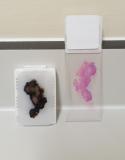Test Directory
FOXO1 gene rearrangement
Containers - Adult

FFPE block / H&E slide / Pathology report
|
|
Laboratory Site
Old Dalkeith Road
Edinburgh
EH16 4SA
Transport arrangements
Referral specimens should be sent directly to Molecular Pathology at the above address (see transport recommendations). For patients with pathology specimens held within NHS Lothian there is no need to arrange transport of specimens.
How to request
Testing for NHS Lothian patients can be requested by email to molecular.pathology@nhslothian.scot.nhs.uk or by discussion with an NHS Lothian Pathologist. Referral requests may be accompanied by a completed request form or covering letter.
Please also refer to our detailed requesting instructions.
Availability
Monday - Friday. 09:00 – 17:00
Anticipated turnaround
Turnaround times will vary depending on the nature of the report required.
Individual FISH results should be available within 10 working days. See results.
Static information/disclaimer
This test is accredited to ISO 15189.
Please note, alternative methodologies may be used. Full details will be included in all reports.
General additional information
Forkhead box protein O1, also known as forkhead in rhabdomyosarcoma (FKHR) is encoded by the FOXO1 gene. It is a transcription factor that negatively regulates adipogenesis and functions as a tumour suppressor gene, inactivated by fusions with PAX7 and PAX3 in alveolar rhabdomyosarcoma, the most common soft tissue malignancy in childhood. These features are used in the differential diagnosis from embryonal rhabdomyosarcoma and spindle cell/sclerosing rhabdomyosarcoma, in which therapeutic modalities are distinct and which typically do not harbour fusions. FOXO1 amplification has been described in 93% of PAX7-FOXO1 and 9% of PAX3-FOXO1 fusions by one study, and was associated with significantly improved outcome compared with the respective unamplified aberrations.
A positive FOXO1 gene rearrangement result is considered to be supportive evidence where a pathological diagnosis of alveolar rhabdomyosarcoma is being considered.
FOXO1 gene rearrangements are detected by break-apart fluorescence in-situ hybridisation (FISH) analysis. The method will identify a chromosomal rearrangement involving the FOXO1 locus at 13q14, but not the specific gene fusion partner.
For clinical advice on appropriate investigations, please contact our Molecular Pathology team.